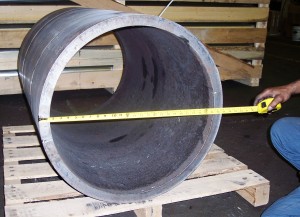Equipment manufacturers often purchase rolled steel sections–angles, bars, beams, tees, pipe and tube–that are formed to a specified radius by companies that specialize in curving metal.
Especially when developing new curved parts, the process usually takes the form of an engineer contacting the Bender/Roller asking if a particular metal section can be curved to a given radius through a given number of degrees without distortion. Often a back-and-forth discussion results in agreement on the optimal design for the required use. Sometimes samples are supplied to the equipment manufacturer with or without charges for labor and material by the supplier.
Equipment manufacturers often require a PPAP, a production approval process, originally used in the automobile industry but now applied to other industries.
This process strives to establish confidence in component suppliers and their production processes, by demonstrating that:
“…all customer engineering design record and specification requirements are properly understood by the supplier and that the process has the potential to produce product consistently meeting these requirements during an actual production run at the quoted production rate.”
Budgetary pricing can be firmed up to become the final pricing as the Bender/Roller and its customer agree on the optimal solution.
Once the order is placed and parts are put into production, it is important to maintain communication between the supplier and the customer not only to insure that all is going well with quality, delivery, service and value but also to seek continual improvement in every aspect of the manufacturing process. Ideally, for example, the workers on the supplier’s shop floor would visit the customer’s shop workers and see exactly what’s working and what could be improved. Such communication, of course, can greatly benefit both parties. Something as simple as the font size on a drawing can improve the quality of the finished parts.
Similarly, templates, go/no go gauges, and other fail-safe devices can insure that a steady supply of quality parts hits the customer’s floor when needed. Again, clear and continual communication will yield the desired results.








